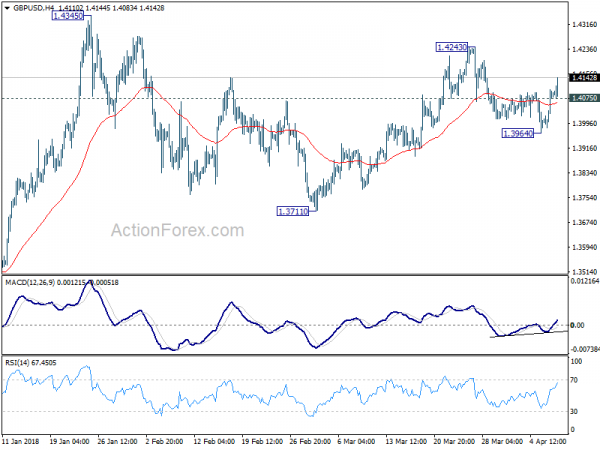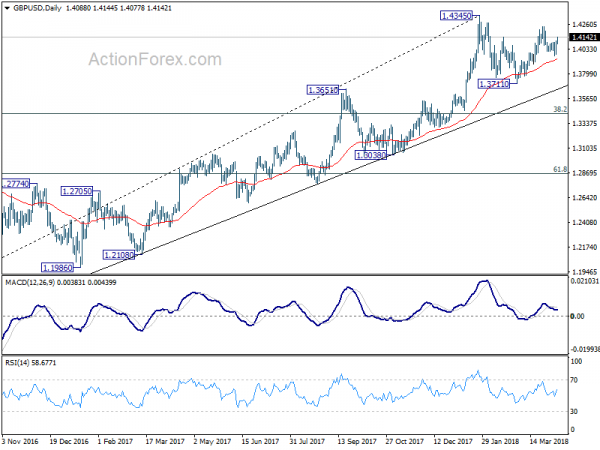Sterling surges broadly today and is so far trading as the strongest one. Some point to solid housing data as a trigger for the buying. Mortgage lender Halifax house price rose more than expected by 2.7% in Q1. And that should be something welcomed by BoE hawks on their push for May rate hike. Nonetheless, to us, the Pound’s rally today is more technical than fundamental. In particular, UK seems to have turned quiet after Brexit transition deal, while trade war drums are beating elsewhere in the world. As pointed out earlier in the Daily Report, GBP/USD does extend it’s rebound from 1.3964 and affirm it’s near term bullish news. GBP/JPY’s break of 150.92 resistance should now align the bullish outlook together.
Elsewhere, in the currency markets, Dollar is under heavy selling right into US session, especially against European majors. But for the day, Yen is trading as the weakest one. Canadian Dollar followed as the second weakest as it’s getting more unlikely for even a symbolic NAFTA deal to be signed this week. Mexican Economy Minister Ildefonso Guajardo was quoted that there aren’t conditions right now for NAFTA deal to be reached this week. He believed that is 80% chance of a symbolic, principle agreement by the first week of May, as the US would like to push for it.
China said to consider currency devaluation as a weapon in trade spat
Ahead of China President Xi Jinping’s address in the Boao Forum for Asia on Tuesday, there are rumors that China is considering currency devaluation as a weapon in the trade spat with the US. Bloomberg reported that Chinese officials are studying the impact of yuan depreciation on two fronts. Firstly, analysis was taken to look at using currency depreciation as a weapon in the trade war with the US. Secondly, it’s also studied how yuan depreciation could help offset any trade deal with US that curb exports.
However, the accuracy of the news is suspectable as there was no named source, and Bloomberg just said it’s from “people familiar with the matter”, not even an government officials. Also, Yuan devaluation could destabilize the China’s own markets, and that could do more harm to itself than to the US. Politically, it’s against what China is portraiting. That is, China sees itself as following WTO rules and is trying to draw support from other countries against US unilateralism and protectionism. Devaluating Yuan would only alien China from those whom it could ally against the US on trade.
Meanwhile, there were expectations that Xi would make use of the Boao Forum fight back against the US. Or, there were expectations that Xi would say something that eventually launch trade negotiations. But it should be noted that Xi’s leadership and communication style is clearly very different from Trump’s. It’s somewhat unrealistic to expect him to say something over the top.
Meanwhile, China is so far adopting a passive but quick in response tactic. That is, it wouldn’t anything until the US make a step. Such tactics give China a ground to claiming that the US started the problems. Hence, it’s expected that is the US doesn’t initial a discussion, there won’t be negotiations. So far, we only see Trump raising the threats to China. We saw Trump ordering Trade Representative to study tariffs on another USD 100b of Chinese imports. But we haven’t seen Trump ordering anyone to start the negotiation quickly. No matter what Xi says tomorrow, the ball would still be in Trump’s court.
Eurozone Sentix: Significant economic slowdown must now be assumed
Eurozone Sentix investor confidence dropped notably to 19.6 in April, down from 24.0 and missed expectation of 19.6. Current situation index dropped from 24.0 to 19.6, continuing the decline from January’s high of 32.9. Expectation index turned negative to -1.5, down from March’s 4.3. That’s also a continuation of the fall from 18.8 started back in January. Sentix noted in the released that the global economy is “cooling off” And negative expectation for Eurozone for indicated “a turnaround in the previous months” and “a significant economic slowdown must now be assumed.” In particular, the customs dispute fueled by US President Donald Trump are “leaving their traces”.
Regarding the US, Sentix warned that “common sense” would assume the US demands on trade were “merely negotiation tactics”. But Trump is consistent working through its “America first” agenda, thus, the threats could become implementations. The “positive effects of the tax reform have quickly evaporated, and expectations for the US economy are plummeting.”
Also released in European session, German trade surplus narrowed to EUR 19.2b in February. Swiss unemployment rate was unchanged at 2.9% in March.
BoJ Kuroda reiterated there’s some distance to 2% inflation
BoJ Governor Haruhiko Kuroda held his inaugural press confidence today. There he repeated familiar comments. Kuroda said that while the “economy and prices are doing quite well now”, there is still “some distance” to achieving the 2% inflation target. And therefore, it’s “inappropriate to tighten policy or diminish monetary support” for the sake of creating “policy room to cope with a future downturn:. And, he emphasized that any monetary policy shift would be cautious and gradual” just what what Fed and ECB are doing.
Released from Japan today, current account surplus narrowed to JPY 2.02% in February. Consumer confidence was unchanged at 44.3 in March.
GBP/USD Mid-Day Outlook
Daily Pivots: (S1) 1.4011; (P) 1.4058; (R1) 1.4134; More….
GBP/USD’s rally from 1.3964 continues today and reaches as high as 1.4139 so far. Intraday bias remains on the upside for 1.4243 resistance first. Break will target a test on 1.4345 high next. On the downside, below 1.4075 minor support will turn intraday bias neutral first. But outlook will stay cautiously bullish as long as 1.3964 support holds.
In the bigger picture, as long as 1.3651 resistance turned support holds, medium term outlook in GBP/USD will remain bullish. Rise from 1.1946 is at least correcting the long term down trend from 2007 high at 2.1161. Further rally would be seen back to 38.2% retracement of 2.1161 (2007 high) to 1.1946 (2016 low) at 1.5466. However, GBP/USD fails to sustain above 55 month EMA (now at 1.4267) so far. Break of 1.3651 will be the first sign of medium term reversal and turn focus to 1.3038 support for confirmation.
Economic Indicators Update
| GMT | Ccy | Events | Actual | Forecast | Previous | Revised |
|---|---|---|---|---|---|---|
| 22:30 | AUD | AiG Performance of Construction Index Mar | 57.2 | 56 | ||
| 23:50 | JPY | Current Account (JPY) Feb | 1.02T | 1.39T | 2.02T | |
| 05:00 | JPY | Consumer Confidence Mar | 44.3 | 44.5 | 44.3 | |
| 05:45 | CHF | Unemployment Rate Mar | 2.90% | 2.90% | 2.90% | |
| 06:00 | EUR | German Trade Balance Feb | 19.2B | 23.1B | 21.3B | |
| 08:30 | EUR | Eurozone Sentix Investor Confidence Apr | 19.6 | 20.8 | 24 | |
| 14:30 | CAD | BoC Overall Business Outlook Survey Q1 |















